
Armen Leonovich Takhtajan or Takhtajian, was a Soviet-Armenian botanist, one of the most important figures in 20th century plant evolution and systematics and biogeography. His other interests included morphology of flowering plants, paleobotany, and the flora of the Caucasus. He was one of the most influential taxonomists of the latter twentieth century.

The A.V. Fomin Botanical Garden is one of the oldest botanical gardens in Ukraine, located in Kyiv, the capital of Ukraine. In 1839 the Saint Vladimir Imperial University of Kiev opened its own botanical garden. The botanical garden is 22.5 hectares (0.225 km2), with 8,000 plant species, including 143 recorded in the Ukraine's Red Book of Rare Species. The Garden is famous for its exotic plants: it has the biggest collection of succulents among the countries of the former Soviet Union. The greenhouse, which was built for the largest and the oldest palm trees in Northern Eurasia, is among the highest in the world. In 1935 the garden was named after the academician and botanist Aleksandr Vasiljevich Fomin, who directed the garden for years. The vestibule of the Kyiv Metro station Universytet, is located on the northern edge of the garden, which was opened in 1960.(Google Maps link).
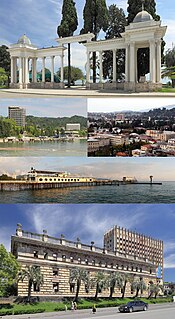
Sukhumi or Sokhumi, also known by its Abkhaz name Aqwa, is a city in a wide bay on the Black Sea's eastern coast. It is both the capital and largest city of the Republic of Abkhazia, which has controlled it since the Abkhazia war in 1992-93. The city, which has an airport, is a port, major rail junction and a holiday resort because of its beaches, sanatoriums, mineral-water spas and semitropical climate. It is also a member of the International Black Sea Club.
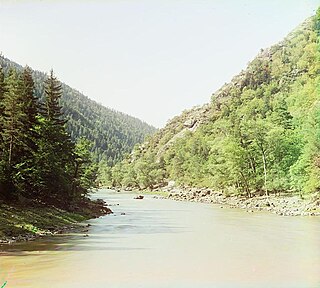
The Bzyb or Bzipi is one of the two largest rivers of Abkhazia, along with the Kodori and the twelfth longest river in Georgia. The river valley has rich biodiversity of herbaceous garden plants, particularly in the gorge section in the upper reaches where the most prominent and colourful bellflower Campanula mirabilis with profuse growth of 100 flowers per plant is given the name, the "Queen of the Abkhazian flora". During 1904-1917 it served as the border between Russian Empire's Sukhumi Okrug and Black Sea Governorate.
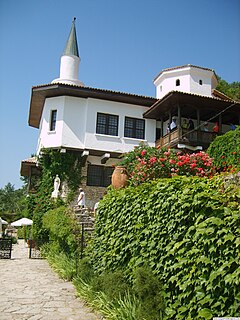
The Balchik Palace is a palace in the Bulgarian Black Sea town and resort of Balchik in Southern Dobruja. The official name of the palace was the Quiet Nest Palace. It was constructed between 1926 and 1937, during the Romanian control of the region, for the needs of Queen Marie of Romania. The palace complex consists of a number of residential villas, a smoking hall, a wine cellar, a power station, a monastery, a holy spring, a chapel and many other buildings, as well as most notably a park that is today a state-run botanical garden. Balchik Palace is 17 metres (56 ft) above sea level.

Andromeda Botanic Gardens is a 6-acre (2.4 ha) botanical garden and an historic cultural attraction in the village of Bathsheba, Saint Joseph in Barbados. It is an authentic garden created by multiple award-winning horticulturalist Iris Bannochie, a female, Barbadian, self-taught scientist. It is unique, having been created from the 1950s as both a private botanical garden and a pleasure garden by an individual. Named from the Greek mythological figure of Andromeda it started as a private plant collection around Ms Bannochie's home, who was also the leading expert on horticulture on the island. Ms Bannochie wrote various academic papers from topics including the lifecycle of the whistling frog, and the vitamin C content of the Barbadian cherry. She was a mentor to many and considered the queen of Barbadian horticulture. At one point, she was responsible for introducing over 80% of the ornamental plants found in Barbados.

The Orto Botanico Comunale di Lucca is a botanical garden located at Via del Giardino Botanico, 14, Lucca, Italy, and operated by the city. It is open daily during the warmer months, and weekday mornings off-season. An admission fee is charged.

The Orto Botanico di Firenze, also known as the Giardino dei Semplici, the "Garden of simples", is a botanical garden maintained by the University of Florence. It is located at Via Micheli, 3, Florence, Italy, and open weekday mornings.

This article refers to the history of Abkhazia from its pre-historic settlement by the lower-paleolithic hunter-gatherers to the post-1992-1993 war situation.
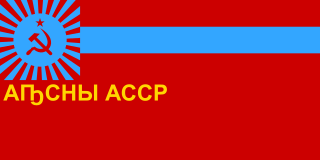
The Abkhaz Autonomous Soviet Socialist Republic, abbreviated as Abkhaz ASSR, was an autonomous republic of the Soviet Union within the Georgian SSR. It came into existence in February 1931, when the Socialist Soviet Republic of Abkhazia, originally created in March 1921, was transformed to the status of Autonomous Soviet Socialist Republic within the Georgian SSR.
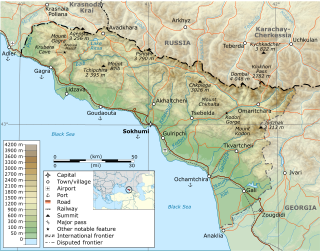
The War in Abkhazia was fought between Georgian government forces for the most part and Abkhaz separatist forces, Russian government armed forces and North Caucasian militants between 1992 and 1993. Ethnic Georgians who lived in Abkhazia fought largely on the side of Georgian government forces. Ethnic Armenians and Russians within Abkhazia's population largely supported the Abkhazians and many fought on their side. The separatists received support from thousands of North Caucasus and Cossack militants and from the Russian Federation forces stationed in and near Abkhazia.

The Batumi Botanical Garden is a 108 hectare area of land 9 km north of the city of Batumi, capital of Autonomous Republic of Adjara, Georgia. Located at the place called Mtsvane Kontskhi on the Black Sea shore, it is one of the largest botanical gardens in the former Soviet Union.
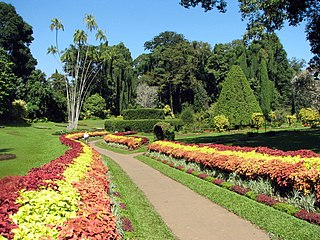
Royal Botanic Gardens, Peradeniya are about 5.5 km to the west of the city of Kandy in the Central Province of Sri Lanka. In 2016, the garden was visited by 1.2 million locals and 400,000 foreign visitors. It is near the Mahaweli River. It is renowned for its collection of orchids. The garden includes more than 4000 species of plants, including orchids, spices, medicinal plants and palm trees. Attached to it is the "National Herbarium of Sri Lanka". The total area of the botanical garden is 147 acres (0.59 km2), at 460 meters above sea level, and with a 200-day annual rainfall. It is managed by the Division of National Botanic Gardens of the Department of Agriculture.

Giardino dell'Iris is a botanical garden specializing in the cultivation of iris flowers, symbol of Florence since 1251. It is located on the corner of Viale dei Colli and Piazzale Michelangelo in Florence, Italy, and open daily without charge from May 2–20 every year.

The Bernardine Garden, previously known as Sereikiškės Park, is a public park in the city of Vilnius, Lithuania. It is located on the right bank of the Vilnia River between the Gediminas Tower and Bernardine Monastery and covers over 9 hectares. Most of its territory is parkland, divided in the monastery exposition, the botanic exposition and other recreational territory including a children's amusement park. It hosts a variety of festivals and exhibitions, including an amateur chess championship of Ostap Bender.

Evgenii Vladimirovich Wulff (1885–1941) was a Crimean Russian Soviet biologist, botanist and plant geographer.
Tourism in Abkhazia is possible under Georgian law for foreigners entering the occupied territory from Georgia, although Georgia cannot assure the safety inside disputed territory. However, the Abkazian beaches on the Black Sea continue to be accessible for tourists coming from the Russian side of the Abkhazia–Russia border which is not under Georgian control. Low prices and an absence of any visa requirements attracts Russian tourists especially those who can not afford the vacations in Turkey, Egypt, Bulgaria and other popular Russian touristic directions.
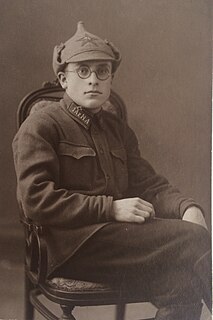
Andrey Aleksandrovich Fedorov was a Soviet Russian biologist, botanist, taxonomist and phytogeographer, who was from 1970 a corresponding member of the Academy of Sciences of the USSR. He was the brother of the botanist Alexander Fedorov (1906-1982).

The Sukhumi or Sukhum Okrug was a special administrative okrug (county) in the Caucasus Viceroyalty of the Russian Empire, part of the Kutais Governorate from 1883 until 1905. The administrative center of the district was the Black Sea port city of Sukhum (Sukhumi). The okrug bordered the Kutais Governorate to the southwest, the Kuban Oblast to the north and the Black Sea Governorate to the northwest and in terms of its area corresponded to most of contemporary Abkhazia. During 1905-1917 the Sukhumi Okrug was one of the smallest independent administrative units of the Russian Empire, second to the Zakatal Okrug.

Over time Joseph Stalin resided in various places.



















